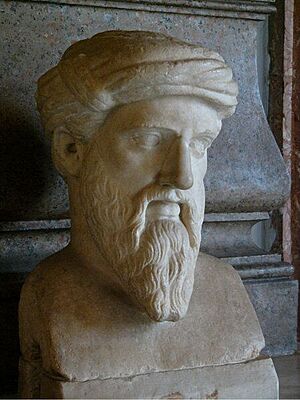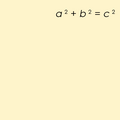Pythagoreanism facts for kids

Pythagoreanism is a name for the special ideas and beliefs held by Pythagoras and his followers. They were called Pythagoreans and loved mathematics. They believed that the whole world was made of numbers. They also thought that different integers (whole numbers) had special, sacred meanings.
Later, new groups of people had similar ideas to the early Pythagoreans. These ideas are sometimes called Neopythagoreanism.
Contents
Pythagorean Ideas
Pythagoreans believed that numbers were the key to understanding everything. They thought that numbers were not just for counting, but that they had a deep spiritual meaning.
Numbers and the World
They believed that the universe was ordered by numbers and musical harmony. For example, they saw how musical notes could be explained by simple number ratios. This made them think that everything, from the stars to human behavior, followed mathematical rules.
Special Symbols
The Pythagoreans used several symbols that were important to their beliefs. These symbols often represented numbers or geometric shapes that they thought were sacred.
- Monad: This symbol represented the number one. It was seen as the source of all other numbers and the beginning of everything.
- Dyad: This symbol represented the number two. It stood for opposites, like light and dark, or good and bad.
- Triad: This symbol represented the number three. It was important in many ways, like the idea of a beginning, middle, and end.
- Tetrad: This symbol represented the number four. It was linked to the four elements (earth, air, fire, water) and the four seasons.
- Pentad: This symbol represented the number five. It was often linked to health and balance.
- Decad: This symbol represented the number ten. It was considered the perfect number because it was the sum of the first four numbers (1+2+3+4=10).
- Tetractys: This was a special triangle shape made of ten dots arranged in four rows. It was very important to the Pythagoreans and represented the universe.
- Vesica piscis: This is a shape made by two circles overlapping. It was also a sacred geometric symbol for them.
Life and Rules
Pythagoreans lived by certain rules. They believed in living a simple life and being kind to others. They also had rules about what they could eat. For example, they famously refused to eat beans. The exact reason for this rule is still a mystery, but it was a very important part of their way of life.
Images for kids
-
In Raphael's famous painting The School of Athens, Pythagoras is shown writing in a book. A young man is giving him a tablet that shows a lyre and the sacred tetractys.
-
The Plimpton 322 tablet is an ancient Babylonian tablet. It shows examples of Pythagorean triples (sets of three whole numbers that fit the Pythagorean theorem) from a very long time ago.
-
Bust of Pythagoras from the Musei Capitolini in Rome.
-
A medieval woodcut by Franchino Gaffurio. It shows Pythagoras and Philolaus studying music together.
-
Pythagoras and faba beans from a French artwork (1512/1514). Pythagoreans did not eat beans. People have wondered why for a long time.
-
A page from Fibonacci's book Liber Abaci. It shows the Fibonacci sequence with numbers written in Eastern Arabic numerals.
-
Pythagoras is shown in a stone carving on the archivolts (arches) over a door at Chartres Cathedral.
-
The first edition of Harmonices Mundi (The Harmony of the World) by Johannes Kepler, published in 1619.
See also
 In Spanish: Pitagóricos para niños
In Spanish: Pitagóricos para niños















